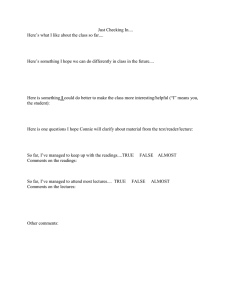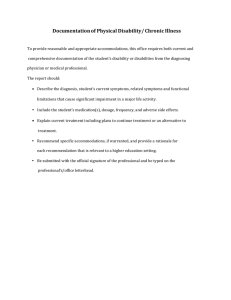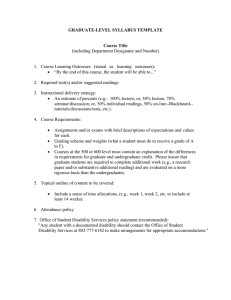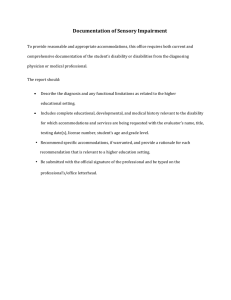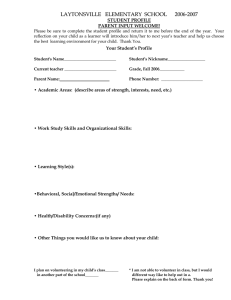E. Aguado Office: Storm Hall 305 C Geography 320, California
advertisement
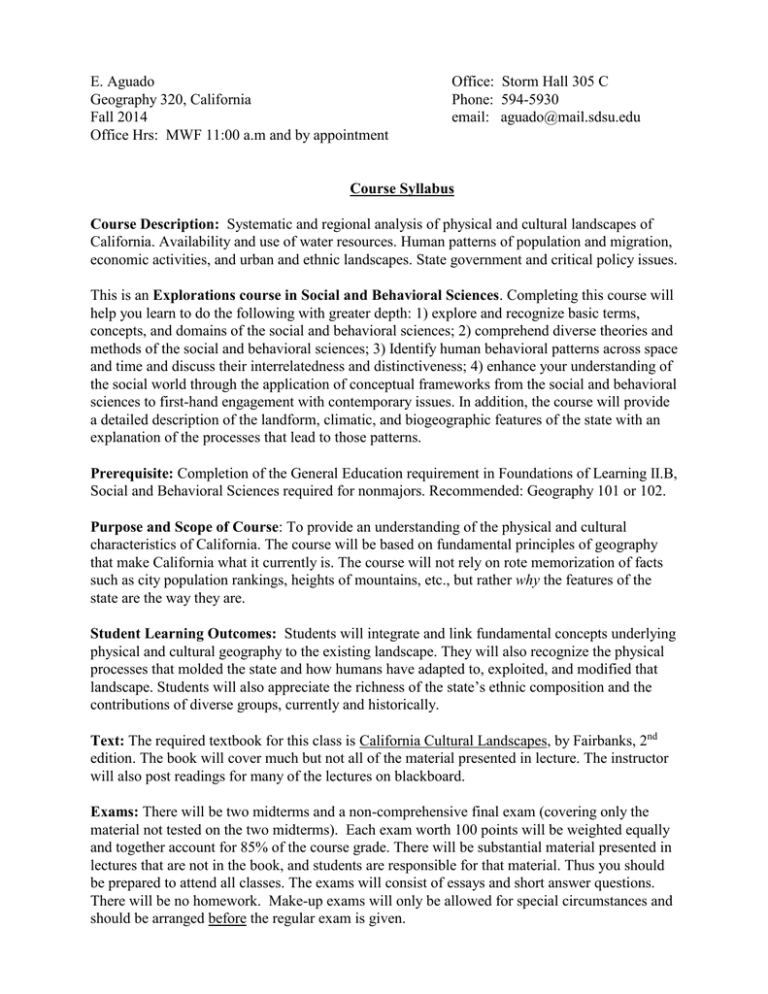
E. Aguado Geography 320, California Fall 2014 Office Hrs: MWF 11:00 a.m and by appointment Office: Storm Hall 305 C Phone: 594-5930 email: aguado@mail.sdsu.edu Course Syllabus Course Description: Systematic and regional analysis of physical and cultural landscapes of California. Availability and use of water resources. Human patterns of population and migration, economic activities, and urban and ethnic landscapes. State government and critical policy issues. This is an Explorations course in Social and Behavioral Sciences. Completing this course will help you learn to do the following with greater depth: 1) explore and recognize basic terms, concepts, and domains of the social and behavioral sciences; 2) comprehend diverse theories and methods of the social and behavioral sciences; 3) Identify human behavioral patterns across space and time and discuss their interrelatedness and distinctiveness; 4) enhance your understanding of the social world through the application of conceptual frameworks from the social and behavioral sciences to first-hand engagement with contemporary issues. In addition, the course will provide a detailed description of the landform, climatic, and biogeographic features of the state with an explanation of the processes that lead to those patterns. Prerequisite: Completion of the General Education requirement in Foundations of Learning II.B, Social and Behavioral Sciences required for nonmajors. Recommended: Geography 101 or 102. Purpose and Scope of Course: To provide an understanding of the physical and cultural characteristics of California. The course will be based on fundamental principles of geography that make California what it currently is. The course will not rely on rote memorization of facts such as city population rankings, heights of mountains, etc., but rather why the features of the state are the way they are. Student Learning Outcomes: Students will integrate and link fundamental concepts underlying physical and cultural geography to the existing landscape. They will also recognize the physical processes that molded the state and how humans have adapted to, exploited, and modified that landscape. Students will also appreciate the richness of the state’s ethnic composition and the contributions of diverse groups, currently and historically. Text: The required textbook for this class is California Cultural Landscapes, by Fairbanks, 2nd edition. The book will cover much but not all of the material presented in lecture. The instructor will also post readings for many of the lectures on blackboard. Exams: There will be two midterms and a non-comprehensive final exam (covering only the material not tested on the two midterms). Each exam worth 100 points will be weighted equally and together account for 85% of the course grade. There will be substantial material presented in lectures that are not in the book, and students are responsible for that material. Thus you should be prepared to attend all classes. The exams will consist of essays and short answer questions. There will be no homework. Make-up exams will only be allowed for special circumstances and should be arranged before the regular exam is given. -2Term Paper: Student will write a 2000-2500 word term paper, worth 15% of the class grade, on some salient feature of California. The topic of the paper can be on anything about the physical or human landscape of the state, such as the causes and impacts of Santa Ana winds, the development of an ethnic community in San Diego, current controversy regarding the Peripheral Canal, etc. The paper is due by noon, Friday, December 19. More details will be provided during the semester. Grading Standards: Exams and the term paper will be assigned points from 0 to 100. The final course grade will be based on the cumulative number of points accumulated and based on the overall distribution of points. Rather than using a predetermined number of points for each grade (e.g., 70% = C), the instructor will look for natural gaps in the point distribution and give grades based on the clustering of scores. The tentative grade distribution will be given to the class after each exam is graded. Extra Credit: There will be no extra credit opportunities for this class Disabled Students If you are a student with a disability and believe you will need accommodations for this class, it is your responsibility to contact Student Disability Services at (619) 594-6473. To avoid any delay in the receipt of your accommodations, you should contact Student Disability Services as soon as possible. Please note that accommodations are not retroactive, and that accommodations based upon disability cannot be provided until you have presented your instructor with an accommodation letter from Student Disability Services. Your cooperation is appreciated. Exam Dates: Exam 1: Friday, September 26 (subject to change with prior notice) Exam 2: Friday, October 31 (subject to change with prior notice) Final Exam: Monday, December 15, 8 a.m. Classroom Etiquette (Important!): Students are expected to devote the class period to the lectures being delivered. At no time during lectures should you be checking any electronic devises for email, texting or other such activities. Instructors do, in fact, see what is going on in class and consider such activities rude when she or he is delivering the material that they spent time organizing. The instructor will allow the use of laptop computers in class for note taking only. If students decide to check emails, update their Facebook page, or engage in other non-academic activities, there will be a no-computer policy. -3Course Outline I. General Overview (Skim Chapter 1; posted reading) A. Introduction B. Human/Environment Interaction C. Landform Regions 1. Northern Mountains and Plateaus 2. Coast Ranges 3. Central Valley 4. Sierra Nevada 5. Basin and Range 6. Transverse and Peninsular Ranges 7. Southern Deserts II. Geology and Geomorphology (Chapter 2) A. Basic Concepts 1. Geologic Time 2. Rock Cycle B. Earth’s Interior and Basic Processes Volcanism Faulting Folding C. Plate Tectonics D. California Chronology E. Geologic Regions F. California Faults and Earthquakes G. Landslides on other Mass Movements in California H. Rivers, Glaciers and Coastal Features III. Climate (Chapter 3) A. Effects of Geographical Situation B. Basic Weather Processes C. California Major Wind Patterns 1. Sea breeze 2. Santa Anas D. Climate and Wildfires E. El Nino and PDO F. Air Pollution G. Climate Variation by Landform Region IV. Vegetation (pp. 57-64) A. Biological Regions of California B. Controls of Vegetation Patterns C. California Plant Communities D. Human Effects -4V. Water Resources and Hydrology (Chapter 11 and readings to be posted) A. Basic Water Budget B. Freshwater Environments C. Historical Distribution of Water 1. Native Americans 2. Spanish Era 3. Mexican Era 4. Anglo Settlers D. Water Projects 1. Central Valley Flood Control 2. San Francisco Bay Area 3. Los Angeles, Owens Valley 4. Colorado River and Metropolitan Water District 5. Central Valley Project 6. California Water Project E. Groundwater F. Examples of Conflicts 1. Lake Casitas 2. Peripheral Canal VI. Native American Landscapes (Chapter 5) A. Regions B. Languages and Methods of Subsistence VII. Spanish Exploration and Settlement (Chapter 6) A. Missions, Presidios and Pueblos B. Other Settlers VIII. Mexican Rancho Era (Chapter 7) A. Trade and Economic Growth B. Ranchos and Mission Secularization C. Cultural and Economic Landscape IX. Gold Rush (Chapter 8) X. The Beginnings of Modern California (Chapter 9) A. Early Transportation and Communications B. Railroads C. Shift of Population Southward -5XI. Population Patterns and Changes (Assigned readings) A. History and Growth of Population B. Migration Patterns and their Effects C. Factors Influencing Migration Patterns D. Immigrants and Their Effects (break) E. Illegal Immigration F. Prison Population G. Poverty H. Politics XII. Infrastructure (Assigned readings) A. Higher Education B. State Budget C. Labor Force D. Transportation XIII. Agriculture and Industries (Chapter 10 and assigned readings) A. Farming B. Forestry C. Mining D. Manufacturing and High Tech E. Tourism XIV. Rise of the Modern California Landscape (Chapter 12) A. WWII B. Modern Cultural Conflict and Migration C. Suburbanization D. Some Current Issues XV. Modern Cultural Patterns and Regions (Chapter 13)

